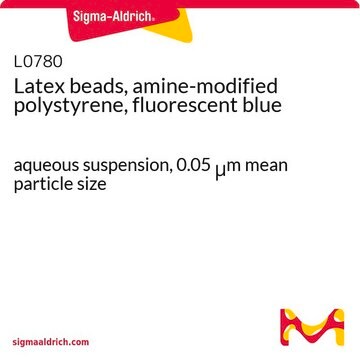66019
Nano beads based on polyacrylonitrile, Chromeon 642-marked, carboxylated
Synonim(y):
PAN-Chromeon 642, carboxylated
Zaloguj sięWyświetlanie cen organizacyjnych i kontraktowych
About This Item
Kod UNSPSC:
12352200
Formularz
liquid
stężenie
0.5%
średnia średnica
80-100 nm
fluorescencja
λex 642 nm; λem 677 nm in H2O
temp. przechowywania
2-8°C
Zastosowanie
Nanobeads based on polyacrylonitrile, Chromeon 642-marked, carboxylatedis an effective vehicle for energy transfer with external fluorescent dyes and embedded dyes making them useful in FRET-based immunoassay applications such as protein nanoarray and quantum dot assays.
Ta strona może zawierać tekst przetłumaczony maszynowo.
Kod klasy składowania
12 - Non Combustible Liquids
Klasa zagrożenia wodnego (WGK)
WGK 3
Temperatura zapłonu (°F)
Not applicable
Temperatura zapłonu (°C)
Not applicable
Środki ochrony indywidualnej
Eyeshields, Gloves
Wybierz jedną z najnowszych wersji:
Masz już ten produkt?
Dokumenty związane z niedawno zakupionymi produktami zostały zamieszczone w Bibliotece dokumentów.
Klienci oglądali również te produkty
Hye-Young Park et al.
Langmuir : the ACS journal of surfaces and colloids, 26(10), 7327-7333 (2009-12-25)
The generation of compact quantum dots (QDs) probes is of critical importance for visualizing molecular interaction occurring in biological context, particularly when using the Förster resonance energy transfer (FRET) approach. This Article reports novel water-soluble compact CdSe/ZnS QDs prepared by
R Bruck et al.
Biosensors & bioelectronics, 26(9), 3832-3837 (2011-03-23)
We report the development of a Mach-Zehnder interferometer biosensor based on a high index contrast polymer material system and the demonstration of label-free online measurement of biotin-streptavidin binding on the sensor surface. The surface of the polyimide waveguide core layer
Phat L Tran et al.
Analytical and bioanalytical chemistry, 398(2), 759-768 (2010-07-24)
An alternative approach for fabricating a protein array at nanoscale is suggested with a capability of characterization and/or localization of multiple components on a nanoarray. Fluorescent micro- and nanobeads each conjugated with different antibodies are assembled by size-dependent self-assembly (SDSA)
Nasz zespół naukowców ma doświadczenie we wszystkich obszarach badań, w tym w naukach przyrodniczych, materiałoznawstwie, syntezie chemicznej, chromatografii, analityce i wielu innych dziedzinach.
Skontaktuj się z zespołem ds. pomocy technicznej
